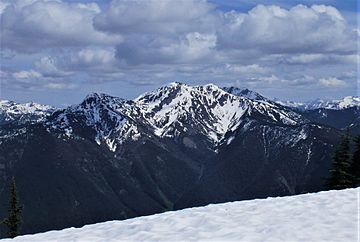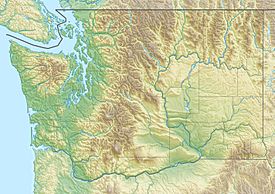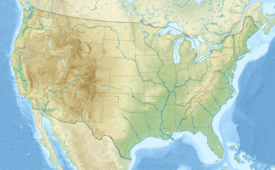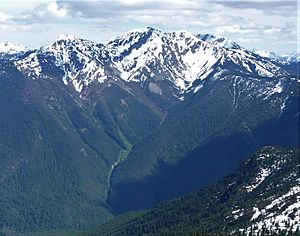Spratt Mountain facts for kids
Quick facts for kids Spratt Mountain |
|
|---|---|

Northwest aspect, from Desolation Peak
|
|
| Highest point | |
| Elevation | 7,258 ft (2,212 m) |
| Prominence | 778 ft (237 m) |
| Isolation | 1.87 mi (3.01 km) |
| Parent peak | Bear Skull Mountain (7,330 ft) |
| Geography | |
| Location | Whatcom County, Washington, U.S. |
| Parent range | Cascade Range North Cascades Hozameen Range |
| Topo map | USGS Jack Mountain |
Spratt Mountain is a tall mountain in Washington state. It stands about 7,258 feet (2,212 meters) high. You can find it in the North Cascades mountain range, specifically in Whatcom County.
This mountain sits on the western side of the Cascade Range. It is also at the western edge of the Pasayten Wilderness. The land around Spratt Mountain is managed by the Okanogan National Forest. Spratt Mountain is part of the Hozameen Range. Other peaks nearby include Skagit Peak to the north and Jack Mountain to the south. Rain and snow from the mountain flow into Ross Lake. This water travels through two creeks, Three Fools Creek and Dry Creek.
How Spratt Mountain Was Formed
The North Cascades mountains have very rugged shapes. They feature sharp peaks, granite spires, and deep valleys carved by glaciers. These amazing shapes were created by geological events that happened millions of years ago. These events caused big changes in the land's height and led to different climates.
The Cascade Range started forming millions of years ago, during the late Eocene Epoch. At that time, the North American Plate was slowly moving over the Pacific Plate. This movement caused many volcanoes to erupt. Also, small pieces of the Earth's outer layers, called terranes, joined together. This process helped create the North Cascades about 50 million years ago.
Later, during the Pleistocene period, which began over two million years ago, large sheets of ice called glaciers moved across the land. These glaciers repeatedly advanced and then melted back. As they moved, they scraped away the land, leaving behind piles of rock. The river valleys in the area now have a "U" shape. This shape was created by these ancient glaciers. The combination of land pushing up (uplift) and cracks in the Earth's crust (faulting), along with glaciation, formed the tall peaks and deep valleys of the North Cascades.
Mountain Weather and Climate
Spratt Mountain is located in a marine west coast climate zone. This type of climate is found in western North America. Most weather systems start over the Pacific Ocean. They then travel northeast towards the Cascade Range.
As these weather systems approach the North Cascades, the tall peaks force the air upwards. This causes the air to cool and drop its moisture. This moisture falls as rain or snow onto the Cascades. Because of this, the western side of the North Cascades gets a lot of rain and snow, especially in winter.
Due to the mild climate and closeness to the Pacific Ocean, temperatures west of the Cascade Crest rarely get very cold (below 0°F or -18°C) or very hot (above 80°F or 27°C). In winter, the weather is usually cloudy. However, in summer, high-pressure systems over the Pacific Ocean often bring clear skies. Because of the ocean's influence, the snow tends to be wet and heavy. This can lead to a high risk of avalanches. The best time to visit or climb Spratt Mountain is usually from July through September, when the weather is most pleasant.




